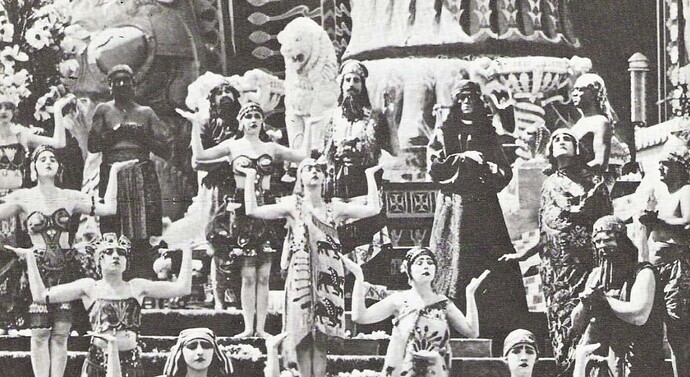“Every man and every woman is a star.”
- Aleister Crowley
This will be integrated into “the Chinese History of Freemasonry and the Neanderthal Origin of the Chinese”.
In 30,000 B.C., the Neanderthal at Denisova cave domesticated the horse.
Wikipedia: “A 32,000-year-old prehistoric species of horse has also been found in the cave.”
In 6,500 B.C., the Homo Neanderthalensis “Ubaid” people invaded southern Mesopotamia, driving the Homo Sapiens “Shemitic” people who had lived there previously to the North.
Wikipedia: “The Ubaid period (c. 6500–3700 BC)[1] is a prehistoric period of Mesopotamia. The name derives from Tell al-'Ubaid where the earliest large excavation of Ubaid period material was conducted initially in 1919 by Henry Hall and later by Leonard Woolley.[2][3]”.
In 6,000 B.C., while still maintaining their capital at Catal Huyuk, and prior to their invasion of China, the Neanderthal are purported to have domesticated the horse on what is now the Russian steppe. With the truth being that they had domesticated it over twenty five thousand years previously, as we learned above.
Wikipedia: “Horses, the scientists conclude, were first domesticated 6000 years ago in the western part of the Eurasian Steppe, modern-day Ukraine and West Kazakhstan.”
Thus, when the “caucasian” R1b haplogroup of the Neanderthal race left those Caucasian mountains to invade western China in 5,500 B.C., they took their pigs, sheep, cattle, horses, metallurgy, pottery, domesticated grains and plants, and cult of human sacrifice and cannibalism right along with them.
Here, even as far back as 5,500 B.C., the distinct and separate race which we know as H. Neanderthalensis had two separate civilizations going, the Chinese and the Sumerian, with each culture basically unaware of the other, yet secretly united by bloodline at the top.
In 5,300 B.C., the distinct and separate Caucasian race which we know as the R1b haplogroup of Homo Neanderthalensis founded the city of Kish in Babylon, in central Mesopotamia. Given that they had the enormous technical superiority provided by metal weapons, the bow and arrow, and the horse, they were able to go where they would with aplomb, setting themselves up on top of whatever indigenous culture they had conquered. They killed all the men, and took all the women.
It’s why the ruling bloodlines of all the nations have the lightest skin.
NIMROD OF BABYLONIAN WAS CHINESE
Wikipedia: “Nimrod the Hunter: A Digression from the Nations List - The Table of Nations has two digressions that appear to be supplements. One is brief— v. 19, which the NJPS translation puts in parentheses—and outlines the borders of Canaan. The other is much more extensive, comprised of five verses about Nimrod (8–12), beginning with:
בראשית י:ח וְכוּשׁ יָלַד אֶת נִמְרֹד הוּא הֵחֵל לִהְיוֹת גִּבֹּר בָּאָרֶץ. Gen 10:8 And Cush begot Nimrod; he began to be a mighty man on earth.
A number of phrases in the passage are difficult to interpret. It could mean anything from גִּבֹּר /gibbōr—The noun גִּבֹּר “giant” (so translated in the Septuagint) to “hero” to “mighty man/warrior” to “champion” to “manItI” to "power” to “potentate.”
Where “difficult to interpret” is Mil-speak for “we’re covering up the fact that Nimrod was a “giant”, a Rephaim, who workshipped the Star of Remphan. The Chinese six-pointed Star of Remphan.
It is crucial to note that only two digressions from the Hebrew Bible’s 70-nation “Table of Nations” list happen to involve the Israelites and the Chinese.
The only two items in the 70-nation list that are obfuscated are the boundaries of Chinese-controlled Canaan and the Chinese lineage of Nimrod.
Wikipedia continues: “The Dissonance between the Nimrod Passage and Its Context - The Nimrod passage interrupts the genealogy of Ham, which continues in verse 12.[11] Moreover, the verses seem to diverge from the structure of the larger genealogical list: it focuses on one individual and the cities he founded, not on the sons he begat.”
Wow! Well, there it is. The Chinese line of Nimrod is the only entry out of 70 in the Table of Nations which does not mention progeny.
*The Chinese progeny of Chinese Nimrod have been written out of the Table of Nations.
Wikipedia continues: “Beginning to be Mighty—Verse 8 tells us that Nimrod הֵחֵל לִהְיוֹת גִּבֹּר בָּאָרֶץ. The word החל means “began,” but “he began to be mighty” makes little sense in this context. The NRSV translates “he was the first on earth to become a mighty warrior,” suggesting a role for him similar to Jabal, Jubal and Tubal-cain, “fathers” of all herders, musicians and metalworkers in Genesis 4:20–22, namely the originators of these professions.”
Nimrod was of the bloodline of Cain. “Nimrod” is a rebranding of Tubal-Cain, the patron Saint of the Masonic religion. Nimrod is also Kassite, which means we’ve figured out that Nimrod is Chinese.
“And the third brother, Tubal Cain, found smithcraft of gold, silver, copper, iron and steele…”
– From “The Legend of the Craft”, by Freemason Albert Mackey
Nimrod was Tubal Cain, of the R1b haplogroup of the Neanderthal bloodline of Cain.
Cain founded the first city, Catal Huyuk, and established metallurgy there. The Neanderthal left Catal Huyuk and invaded China in 5,000 B.C. Nimrod was a Kassite. Nimrod was a Neanderthal metallurgist.
Wikipedia: “The idea of his being “the founder” of some profession works even better with the opening of the next verse, which describes him as a mighty hunter, perhaps making him the first hunter.
בראשית י:ט הוּא הָיָה גִבֹּר צַיִד לִפְנֵי יְ־הוָה עַל כֵּן יֵאָמַר כְּנִמְרֹד גִּבּוֹר צַיִד לִפְנֵי יְ־הוָה. Gen 10:9 He was a mighty hunter before YHWH; therefore it is said: “Like Nimrod a mighty hunter before YHWH.”
This Nimrod, the “mighty hunter before YHWH” is never mentioned elsewhere in the Bible.[5] The anecdote then shifts from describing Nimrod as hunter to king.”
Here we learn that Nimrod, the founder of the profession of metallurgy has been walked back to a single, smoke-blowing reference to “the first hunter” in the Bible. As a bonus, it’s the only reference to Nimrod that exists in the Hebrew Bible. He’s been memory-holed.
Wikipedia: “Identifying Nimrod - We know of no ancient Mesopotamian figure, mythic or historical, named Nimrod. Thus, scholars have struggled to identify who the biblical authors are describing.”
Where “we know of no” and “struggled to identify” are memes used to obscure the fact that Nimrod of Babylon was Chinese.
NIMROD AND SARGON ARE ONE AND THE SAME
“The First Semitic-Speaking Emperor - Legend has it that Sargon, the man who would become what some would call history’s first emperor, was born in the town of Azipiranu on the Euphrates.[16] At birth, his priestess mother hid him in a basket of rushes, which she then set afloat on the river. The basket floated to Kish, where he was adopted by Aqqi the gardener, eventually becoming cup-bearer to Urzababa, king of Kish.[17]”
Here we have the “Moses and the bullrushes” story rebranded. It’s an ironclad connection between the Israelites and Sargon, who would become the King of Kish”.
“Somehow, he managed to become king and expanded his rule over all of southern Mesopotamia, pushing north to conquer Mari, Ebla, Ashur and Nineveh, and even reaching Anatolia and the Mediterranean. At some point, he moved his capital to the previously unknown city of Akkad (its location is unknown), adding the title “King of Sumer and Akkad” to his previous designation “King of Kish.”
He “somehow managed” to become king, ah, mirth. That’s a Mil-speak obstruction to cover up the fact that the O haplogroup H. Neanderthalensis “Chinese” used their chariots, metal weaponry and the bow and arrow to effortlessly conquer the known world. Hilariously, the charlatan writing the piece obscures it, so that you don’t know that the Neanderthal/Chinese empire already encompassed Anatolia and the Mediterranean. The big new development, here, is the driving out of the darker-skinned Shemitic Homo sapiens peoples who had previously occupied Sumeria and Akkad.
“We do not know this person’s birth-name, but as king, he adopted the throne-name Šarru-kîn, which, in the Eastern-Semitic language that came to be known as “Akkadian,” means “the true (or legitimate) King,” indicating that some people doubted his legitimacy. In English, he is known as “Sargon,” following the conventional “biblical” spelling.[18] Sargon was the first known Semitic-speaking Mesopotamian ruler to adapt the Sumerian cuneiform script to his own language, and he reigned over a vast territory for 56 years.
Nimrod’s depiction is based on Sargon.[19] Both Nimrod and Sargon began their reigns in Sumer/Shinʿar, building Akkad and Babylon and continuing north to Assyria. Both were credited with extraordinary prowess. Both were considered to be the first postdiluvians to wield royal power. Thus, Sargon is likely the figure behind Nimrod, though as we will see, he has been amalgamated with his grandson, Naram-Sin.”
Nimrod and Sargon are one and the same. “Nimrod of Babylon” was the Chinese overlord who spoke the Shemitic language of the kingdoms he had overthrown, and used their Sumerian Cuneiform script, as well. He had white skin. He grew a long beard. He wiped away the “Chineseness”. He “went native”. And so at last the Chinese had their two camps, East and West, not appearing to be connected to one another, with which they would go on to set humanity up and knock them down for the rest of recorded history.
From 4,700 B.C. to 2,900 B.C., the Chinese “Hongshan” culture in Northeast China performed human sacrifices, kept domesticated pigs, farmed millet, and carved six-pointed pendants out of what ebay says is “jade”, but it certainly looks like cast iron to me. They descended from the Yangshao culture, in the west and central plains, which also farmed millet.

(Hongshan culture six pointed star pendant - ebay says “jade”, but it certainly looks like cast iron to me.)
From 2,217 B.C. to 2,193 B.C., Nimrod/Sargon I’s great-grandson Shar-kali-shari ruled Babylon for 36 years. He survived a rebellion led by the city of Kish and then restored the empire. Naram-Sin, besides appointing himself the new deity of the city of Akkad (an act of heresy that was later seen as the cause of the empire’s downfall), restructured the bureaucracy, economy and defenses of the kingdom and was known as a patron of the arts. He was also the first to adopt the title šarru kibrâtim arbaʾim, “King of the four corners of the Earth.” During his reign the empire fell apart. A few additional Akkadian rulers are known, but they were no longer powerful emperors, and the city of Akkad was eventually abandoned and lost.”
So what on Earth happened to the Chinese “Babylonians” at Akkad?
In 2,193 B.C., the front-man O-haplogroup Chinese “Babylonians” were driven out of Akkad by the R1b haplogroup Neanderthal-controlled Hurrians from the north.
Wikipedia: “Manneans were a Hurrian group with a slight Kassite admixture. It is unlikely that there was any ethnolinguistic unity in Mannea. Like other peoples of the Iranian plateau, the Manneans were subjected to an ever increasing Iranian (i.e. Indo-European) penetration.”
Where “It is unlikely that there was any ethnolinguistic unity” is Mil speak for “Ethnically, the Hurrians were the R1b haplogroup of the Neanderthal race, with some O-haplogroup Chinese “Kassite” thrown in. They were foot soldiers and charioteers for their Chinese overlords, who spoke their own language”.
The Mannaens have been rebranded by history as “Gutian people”.
Wikipedia: “By the 1st millennium BC, usage of the name Gutium, by the peoples of lowland Mesopotamia, had expanded to include all of western Media, between the Zagros and the Tigris. Various tribes and places to the east and northeast were often referred to as Gutians or Gutium.[4] For example, Assyrian royal annals use the term Gutians in relation to populations known to have been Medes or Mannaeans. As late as the reign of Cyrus the Great of Persia, the famous general Gubaru (Gobryas) was described as the ‘governor of Gutium’.[5]”
Here we can see Wikipedia lie baldfacedly, saying it was the Medes, whom we know would not invade Iran from China from the northwest until 800 B.C.
when it was, in fact, the Manneans, with their H. Neanderthalensis warrior-priest ruling class holding these Guitans or Gutium in their thrall. They who would go on to be rebranded by history as “the Goths”, and eventually roll with unbroken lineage to become the Windsors who now rule the United Kingdom.
I’ve got another article which tracks the lineage, unbroken, from that time to this.
The Chinese “Babylonians” giving way before the caucasian Manneans here in Babylon is a feint. The Chinese are leaving the stage to a different, more “white appearing” appearing actor, who also happens to work for them. Those caucasian “Gutians” are now two levels away from the hidden hand ruling things from the Forbidden City.
In approximately 1,638 B.C., the R1b haplogroup H. Neanderthalensis Israelite “Hyksos” invaded Egypt.
Smithsonian Magazine: “Popular lore suggests the Hyksos, a mysterious group of foreign invaders, conquered the Nile Delta around 1638 B.C. and remained in power until 1530 B.C. But written records of the dynasty are scarce, and modern archaeologists have found few material signs of the ancient military campaign.
One of the things that the Israelites brought with them was the human sacrifice cult of the Chinese god Renpu.
The Egyptians rebranded Renpu as Sheth, the brother of Osiris, helper of man, viz., his helper in Understanding.
His figure, in Egypt, is only found on tablets, and does not belong to the Pantheon of that land.
Not a god. A man. A Neanderthal man.
Here’s the “Asiatic” Israelite Renpu to the left, armed with metal weapons:
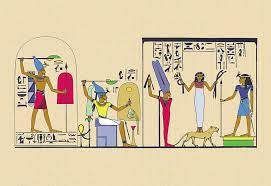
(“Khet, Mistress of Heaven, and Subjects”, by John Gardener Wilkinson - note how the title of the painting takes care not to mention the name “Renpu”.)
“In Sir Gardner Wilkinson’s illustrations of the Egyptian Pantheon, two single representations of this god (Renpu - ed) are given, which differ very slightly in their accessories. Their Egyptian costume (for they wear the crown of the Upper country) shows that they must have been executed for a devotee residing in the Thebaid. Renpu is in a walking attitude, armed to the teeth; he brandishes a battle-axe over his head with his right hand, while his left grasps a shield and spear ; a quiver is slung to his back. The other figure is seated, and has the battle-axe and shield, but neither spear nor quiver.’
“In the triad of the tablet of Kaha, Renpu stands on a pedestal on the left of Astarta-Ken. His right hand holds the long spear, his left the emblem of life. He has no crown, but only the simple fillet and tie round his hair, like that of the Horite chiefs ; and the distinctive oryx’s head projecting in front. **But what is most worthy of attention in this representation, is the form and cut of his beard. Nothing can be more un-Egyptian. It is the peculiar angular clipped beard characteristic of those among the Rephaim race who wear any beard. We need not ask why they affected that particular fashion : their god was shaved so!”
So, who were these Asiatic-appearing “Rephaim”?
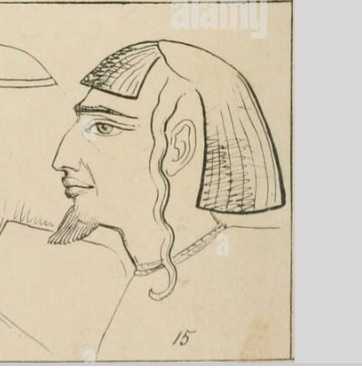
(Israelite “Rephaim” in Egypt - note clipped beard, note ringlets of Hasidic Judaism. )
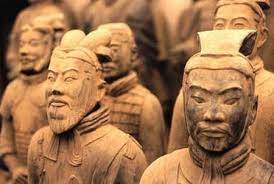
(Distinct clipped beards of the Chinese Terra Cotta warriors)
Rephaim is “a mighty people with tall stature who lived in Canaan.”
Wikipedia: “The Ugaritic material is most problematic because the relevant texts referring to the rpum are fragmentary and difficult to interpret. These rpum, like their Phoenician counterparts, are divine in nature, being referred to as ilnym (I AB 6:46 ff.; Pritchard, Texts, 141; COS I, 357–58), literally “divine ones?” (cf. Heb. eʾlohim, “ghost[s],” literally “divine being[s]” (I Sam. 28:13; Isa. 8:19, 21). There is, however, no clear indication that the rpum are chthonic deities. Moreover, they seem to have a military function. One of their number is referred to as a mhr, the Ugaritic term for soldier, and the rpum are described as riding in chariots.”
Chinese chariot-riding Chinese “Rephaim”.
The “asiatic” Chinese god Renpu which the Israelites brought to Egypt was the Baal of the Chinese Mespotamians:
At some point, Renpu’s name metamorphosized to “Remphan.”
“From his attributes, it corresponds to the Egyptian Baro or Baal. His characteristic emblem is the head of an oryx or a mountain gazelle, which appears projecting from his forehead. This same head is a very prominent emblem among the sacred vessels of the Rephaim ; quite as much so as that of the cow-headed Ashtaroth. In the origin, he was very probably represented with the head of that animal.”
Thus, the god “Renpu”, which Israel had imported into Egypt, was identical to and synonymous to Baal.
“Translators, residing in Egypt at a period when its hieroglyphic writing and mythological system were known matters of every-day teaching, appear to have availed themselves of the knowledge that the tutelar god Sheth of the Midianite region was Sothis, patronymic of the brilliant dog-star.”
That’s Sirius, for those keeping score. Sirius, which the Neanderthal on Malta had been building temples to back to 9,000 B.C.
Renpu, later rebranded to Remphan, was known to the Egyptians as ‘the Incandescent,’ thus rendering it perfectly clear that he was the ‘star-god’ in the explanatory verse that follows.
‘The sacrifices and the offering, did you present them unto Me
In the desert, forty years, O ye sons of Israel?’
Ye bore the shrine of Molech,
And the “Burning-object (chiun) of your images,
And the star of your god Raiphan (for chiun)
Which ye made for yourselves."
“Sothis” was the patron of the dog-star, the ’Incandescent’. He was also Renpu, Raiphan, or Remphan.
(Hollywood “stars”, in background of 1930’s musical, including six-pointed Star of Remphan, center. Also note the young lady in the background with her hands raised in a purportedly-secret Masonic “gesture of recognition”.)
“According to Sanchoniatho, the Phoenicians professed to have been instructed in letters and all useful things by one called Thautus, just like the Egyptians by their Thoth. And this derivation of Thoth from Sheth seems to illustrate the ancient tradition of the ‘pillars of Seth,’ on which the elements of their learning were inscribed and preserved.
The identity of Thoth with Sheth in a special character is admitted by the Egyptians themselves. One of the names of Sheth given by Plutarch, is smu ; whereupon, in his chapter on Sheth, Chev. Bunsen remarks, ’ it reminds us of Thoth’s title Lord of Eshmunein, derived from Shnmn, the eighth. In a passage of the Book of the Dead noticed to us by Birch, we read " Tet, otherwise Set." This intimates that Thoth inherited many of the attributes of Seth.’ And in his chapter on Thoth, the same distinguished author observes on the titles of Thoth, ’ Lord of Shmun — Ilermopolis — literally, lord of the Eighth region ; this reminds us of the well known Cabir Esmun of Phoenicia and Samothrace.’ (P. 427 and 393.) To these suggestions, I will only add ; put them together, and they confirm each other. Smu, given by Plutarch as a title of Seth, is simply Eshmun, a little mangled by the Greek interpreter ; the Phojnician iiDtl’N, derived from pn"‘, eight ; for the title of Thoth in his legends, Lord of shmun-nu, is written with eight strokes ; which proves both the orthography and the etymology of the name : ’ Lord of the region of Eshmun, ’ or ’ the Eighth ;’ and in so doing, **establishes the Phoenician character of the original possessor and patron of the region appropriated to Thoth. This region is still called Oshmounein : the Greeks called it Hermopolis, the city of Hermes, because they identified their ‘Ep;u,r)S, the Interpreter, with Thoth, ’ otherwise Sheth,’ though they derived him from the Pelasgic or Proto-Phoenician Cabir Eshmun, the eighth,’ who is smu the synonym of Sheth. The conclusion arising out of these considerations, is therefore clearly this :
The Egyptian Greeks, therefore, made out Thoth to be Hermes, ‘the interpreter.’
Hence, “the Hermetic Order of the Golden Dawn” which we’ll be getting to much later.
“One of the Khorsabad sculptures given in Mr. Layard’s work on Nineveh contains the figure of Baal, in an attitude and with emblems as evidently copied from the attributes of Sheth the warrior, as those of the AssjTiaii Astarte were from the Atesh of Shittlm. The god is walking ; he has an axe in his right hand, and in his left a bundle of either arrows or thunderbolts. He wears, of course, the Assyrian costume, and his head is adorned with a double pair of horns, but the oryx-emblem is absent.
However, as we know from the Egyptian monumental notices that Sheth, and Baal or ’ Baro who smites his enemies,’ are the same god, the one in his proper local name, the other in a special character, his identity with the Egyptianized Renpu is substantiated by the Assyrian copy of the latter bearing the name of the one with the form of the other. By tracing this god to his original form and home, we obtain another interesting elucidation of a very obscure passage of Scripture : the much-commented and never-explained Amos v. 26, 27.”
Here, we’ve learned that Ba’al and Set are one and the same.
In 300 B.C. the Egyptian historian Manetho wrote his three volume work known as the Aegyptiaca, a lengthy chronological history of Egypt. His work draws on numerous older sources that have since been lost to history.
Manetho describes an Egyptian king named Amenophis (the Greek form of Amenhotep) who was told “that he might see the gods, if he would clear the whole country of the lepers and of the other impure people; that the king was pleased with this injunction, and got together all that had any defect in their bodies out of Egypt; and that their number was 80,000; whom he sent to those quarries which are on the east side of the Nile, that they might work in them, and might be separated from the rest of the Egyptians.”
Manetho related that there was an Egyptian prophet of the same name (Amenophis) who worried that “there were some of the learned priests that were polluted with the leprosy.” He continued: [He] was afraid that the gods would be angry at him and at the king, if there should appear to have been violence offered [against] them; who also added this further, out of his sagacity about futurities, that certain people would come to the assistance of these polluted wretches, and would conquer Egypt, and keep it in their possession thirteen years; however, he durst not tell the king of these things, but left a writing behind him about all those matters, and then slew himself, which made the king disconsolate.
After those that were sent to work in the quarries had continued in that miserable state for a long while, the king was desired that he would set apart the city Avaris, which was then left desolate of the shepherds, for their habitation and protection; which desire he granted them.”
Here we see the Israelite “shepherds”, you know, who were “watching over their flocks by night”? They’re the only people on Earth practicing this animal, er, husbandry, having developed it up at Catal Huyuk several thousand years earlier.
You’ll have to read a different article of mine to learn how all of those “domestic animals” were created by a diabolical interbreeding of humans and various other species. It’s casually alluded to in “the Odyssey”, when Circe turns Odysseus’ men into pigs.
“Enter ‘Moses’ - Now enters Manetho’s “Moses” figure (who is initially introduced with a different, Egyptian name). “But when these men [the ‘leper’ slaves] were gotten into it [their city, Avaris], and found the place fit for a revolt, they appointed themselves a ruler out of the priests of Heliopolis, whose name was Osarsiph, and they took their oaths that they would be obedient to him in all things.” This upstart, according to Manetho, attempted a religious revolution.
He then, in the first place, made this law for them, That they should neither worship the Egyptian gods, nor should abstain from any one of those sacred animals which they have in the highest esteem [e.g. sheep and cattle], but kill and destroy them all; that they should join themselves to nobody but to those that were of this confederacy. … [H]e had made such laws as these, and many more such as were mainly opposite to the customs of the Egyptians ….
Manetho then proceeded to describe this rogue priest-leader preparing for an armed resistance against the Egyptians:
“[Osarsiph] gave order that they should use the multitude of the hands they had in building walls about their city, and make themselves ready for a war with King Amenophis, while he did himself take into his friendship the other priests, and those that were polluted with them, and sent ambassadors to those shepherds who had [already] been driven out of the land by Tefilmosis to the city called Jerusalem; whereby he informed them of his own affairs, and of the state of those others that had been treated after such an ignominious manner, and desired that they would come with one consent to his assistance in this war against Egypt.
These shepherds were all very glad of this message, and came away with alacrity all together, being in number 200,000 men; and in a little time they came to Avaris. And now Amenophis the king of Egypt, upon his being informed of their invasion, was in great confusion, as calling to mind what [the prophet] Amenophis, the son of Papis, had foretold him ….
Manetho’s account describes Pharaoh Amenophis taking radical action to avoid war. He instructed Egypt’s priests to “hide the images of their gods” for safekeeping. He sent his 5-year-old son, Ramesses, to a distant “friend of his” for protection. He then left Egypt with 300,000 chosen men and sacred animals, including the most sacred Apis bull, for a 13-year exile in Ethiopia (“for the king of Ethiopia was under an obligation to him”).
In “The Sacred Procession of Apis”, by F. A. Bridgeman, c. 1900, we read “Exile, Desecration, and Triumphant(?) Return
Based on the prophecy, Amenophis thus avoided a battle against the shepherd-slave-leper forces led by Osarsiph, “thinking that would be to fight against the gods.”
Where “fight against the gods” means, specifically, fighting against Renpu/Baal, and thus fighting against the world superpower Chinese, and their allies, the homo Neanderthalensis Israelites.
Manetho continued (emphasis added):
But for the people of Jerusalem, when they came down … treated the [Egyptians] in such a barbarous manner, that those who saw how they subdued the forementioned country, and the horrid wickedness they were guilty of, thought it a most dreadful thing; for they did not only set the cities and villages on fire but were not satisfied till they had been guilty of sacrilege, and destroyed the images of the gods, and used them in roasting those sacred animals that used to be worshiped, and forced the priests and prophets to be the executioners and murderers of those animals, and then ejected them naked out of the country.”
The Egyptians did not eat cows or sheep. While the invading horde of H. Neanderthalensis “Israelites” were meat eaters, and had been ever since they developed cows and sheep and pigs by hybridizing humans with the wild rams, oxen and boars of the region surrounding Catal Huyuk in what is now Turkey.
“It was also reported that the priest, who ordained their polity and their laws, was by birth of Heliopolis, and his name Osarsiph, from Osyris, who was the god of Heliopolis; but that when he was gone over to these people, his name was changed, and he was called Moses.
Further to this point, there is a heated debate over when the biblical Exodus took place. Biblical chronology firmly places the Exodus in the 15th century b.c.e. (read more about this here). However, a popular trend is to date the Exodus to the 13th century and identify the Exodus pharaoh as Ramesses ii. A key reason for this is the biblical detail about the Israelite construction of the city Raamses (Exodus 1:11). The city Pi-Ramesses was constructed during the reign of Ramesses ii (and was named after him). However, this name is also used in the story of Joseph; thus, opponents to the “Pharaoh Ramesses” theory assert that the biblical name is anachronistic (a later editorial change) for an earlier original site that bore a more obscure name.”
The Hebrew Bible deliberately obscured the actual location, to muddy the trail.
In “Lamentations Over the Death of the First-Born of Egypt”, by C. S. Pearce, from 1877, we read “And what was the earlier, original site of Pi-Ramesses during the 15th-century period in question, according to biblical chronology? It happens to be the city Avaris (a name similar to the root of the word Hebrews, “Avar”). Further, the biblical use of the name “Raamses” may not necessarily refer to the later 13th-century pharaoh Ramesses at all: Could it instead hearken to the Manetho-described son of Amenophis with the same name—a son who has since been lost to history?”
It’s so easy to figure out the mystery, once you figure out the tells. “Lost to history” is Mil-speak for “this is the truth! Don’t look here!”.
The Raamses of the Bible refers to the son of Amenophis described by Manetho. The biblical Exodus took place in the Israelite “Hyksos” city of Avarus (from the Hebrew “Avar”).
Avaris (/ˈævərɪs/; Egyptian: ḥw.t wꜥr.t, sometimes hut-waret; Ancient Greek: Αὔαρις, romanized: Auaris; Greek: Άβαρις, romanized: Ávaris; Arabic: حوّارة, romanized: Hawwara)[5] was the Hyksos capital of Egypt located at the modern site of Tell el-Dab’a in the northeastern region of the Nile Delta.[6] The site at Tell el-Dab’a, covering an area of about 2 square kilometers, is in ruins today, but excavations have shown that, at one point, it was a well-developed center of trade with a busy harbour ***catering to over 300 ships during a trading season.”
That’s Mil-speak for “the Israelites and the Phoenicians invaded Egypt with a 300-ship navy.” Can you see how "catering to states that the ships did not belong to the Hyksos?
And then we’ve got the H. Neanderthalensis connection of Minoan Crete, whose Bull cult goes right back to Catal Huyuk:
Wikipedia: “The temple even has Minoan-like wall paintings that are similar to those found on Crete at the Palace of Knossos. A large mudbrick tomb has also been excavated to the west of the temple, where grave goods, such as copper swords, have been found."
You know, the copper that the distinct and separate race which we know as H. Neanderthalensis first began smelting at Catal Huyuk.
Wikipedia:
“Avaris, along with Tel Kabri in Israel and Alalakh in Syria, also has a record of Minoan civilization, which is otherwise quite rare in the Levant. Manfred Bietak, an Austrian archaeologist and the excavator of Tell Dab’a, has speculated that there was close contact with the rulers of Avaris, and that the large building featuring the frescoes allowed the Minoans to have a ritual life in Egypt. French archaeologist Yves Duhoux proposed the existence of a Minoan ‘colony’ on an island in the Nile delta.[24]”
The wholly-Neanderthal Chinese brought their iron weapons and their bows and arrows and their chariots to Sumer, and to the Levant, and eventually invaded Egypt. The Israelites worshiped the "Asiatic Renpu and the Chinese six-pointed star that was his symbol.
This is ironclad proof of the Chinese origin of Baal worship, Moloch worship, and the worship of Rephaim and his star.
26 But ye have borne the tabernacle of your Moloch and Chiun your images, the star of your god, which ye made to yourselves.
27 Therefore will I cause you to go into captivity beyond Damascus, saith the Lord, whose name is The God of hosts.
The King James Bible, Amos 5:26, 27
In 1,600 B.C., the Chinese/Israelite Neanderthal, which Wikipedia slyly refers to as the “Indo Aryan Mittani” invaded what is now Syria, positioning themselves as overlords upon the Hurrians. Remember, it had been just 38 years earlier when they’d invaded Egypt with 300 ships and taken the place without striking a blow.
Wikipedia:
“This warrior class seems to have been an early part of what became a mass migration of Indo-Iranian peoples into Iran, South Asia, and northern India.”
It’s not a “mass migration”…it’s a military invasion. It is the Neanderthal using their bows and arrows, metal weapons and chariots to take over every nation on Earth.
They killed all the men, and took all the women.
It’s why the ruling bloodlines of all the nations have the lightest skin.
These Guteans were the precursors of or relatives to the Goths, who would go on, through circuitous windings, to the Windsors on the throne in England.
But don’t take my word for it:
“Jan 21, 2019 — Yes, Gutians were ancestors of Goths, Linear Gutian script has been deciphered and we can already read Gutian (Old Gothic) inscriptions.”
In 1,550 B.C., “Amenophis returned back from Ethiopia with a great army, as did his son Rampses with another army also, and that both of them joined battle with the shepherds and the polluted people, and beat them, and slew a great many of them, and pursued them to the bounds of Syria.”
In 1,550 B.C., after being driven out of Egypt in “the Exodus”, the Caucasian Israelites and the red-haired, blue-eyed Neanderthal “Phoenicians” took the 300-ship Navy to Sumeria. The main land force of the Chinese headed overland to Sumeria with the chariots and the archers.
Just a year later, in 1531 B.C., the Chinese “Kassites”and the Israelites and the Phoenicians invaded and took control of Babylon.
Wikipedia: “ In total, about 12,000 Kassite period documents have been recovered, of which only around 10% have been published.”
The fact that only 10% of Kassite documents have been published is an example of what is known in the propaganda trade as a “news blackout”. It’s so that you don’t learn that the Kassites were, in fact, the Chinese.
“The Kassites were very active at Ur.”
The Kassites were a people from outside Mesopotamia, whose origins are unknown, although many authors theorize that they originated in the Zagros Mountains.”
Thus, Nimrod of Babylon was part of an “unknown” group of people from “outside Mesopotamia”.
That would be the Chinese.
Wikipedia: “The Kassites (/ˈkæsaɪts/) were people of the ancient Near East, who controlled Babylonia after the fall of the Old Babylonian Empire c. 1531 BC and until c. 1155 BC (short chronology).”
Iranica.org: “The Kassite (or presumably such) clans are Bimatî (including the “houses” [Éhá] of Nanaktî) and possibly the Samharî (De Graef, 1998, pp. 10 f., is cautious and allows for the alternative Ka-aš-ši-i Bi-ma-ti-i, thereby keeping Bimatî apart from the Kassites). Since they had chariots, they were not nomadic, but were fully settled in segregated rural encampments.”
The Kassites were an “unknown” group of “people” from “outside Mesopotamia” who had chariots. They segregated themselves in separate encampments. They suddenly took over Babylon in 1531 B.C.
The Kassites were the H. Neanderthalensis Chinese.
Wikipedia: “The chariot was military technology that allowed the Shang to excel at war (the Shang Dynasty, 1,600 B.C. to 1,050 B.C.) As we know, the Neanderthal brought the horse with them when they’d invaded Western China thousands of years previously.
In his classic treatment of the subject, Ephraim A. Speiser identified Nimrod’s Cush with the Iranian people that we call the Kassites, who ruled Babylonia from the 16th to the 12th centuries B.C.E.[14] According to this, whoever inserted the J tradition into its present place mistakenly conflated the two. This final option, i.e., a Mesopotamian Cush, is embraced by most scholars and is likely correct.”
Here we can see the added J being thrown in to shut off inquiry down the path of truth: that the Chinese used their “Israelite/Phoenician” fleet of 300 ships to invade Mesopotamia from south and were rebranded by history as “the Kassites” to cloud the picture.
Wikipedia: “The King of Kish - The mid-third millennium B.C.E. was a time of great change in Mesopotamia. After several centuries of rivalry between various Sumerian city-states such as Ur, Uruk, Lagash and Umma, the rulers of the city of Kish managed to establish supremacy over much of southern Mesopotamia. This was the first time one Sumerian city succeeded in doing this.”
It’s a clever bit of sleight-of-hand, in which the single outpost that China had established in Sumeria, Kish, took over the whole country in a lightning war which the propagandist hides behind “managed to establish supremacy”.
Wikipedia: “In successive generations, the title “King of Kish” (šar-kiššati) would come to mean a divinely authorized ruler over all of Sumer and would be claimed at different times by the rulers of various cities.[15] Use of the title “King of Kish” implied being victorious at war, a righteous judge and a builder of cities. Kish, I would argue, is the basis of the Cush of the Nimrod passage (v. 8).”
In 1,415 B.C., the Chinese “Kassites” began producing pottery in Sumeria.
Wikipedia: “Ceramics - The Kassites produced a substantial amount of pottery.[51] It is found in many Moesoptamia cities including Eridu and Tell Khaiber. Archaeologists divide it into three periods, Early Kassite (pre c. 1415 BC), Middle Kassite (c 1415 BC - 1225 BC), and Late Kassite (c. 1225 BC - 1155 BC).[52] Many small pottery kilns, generally no bigger than 2 meters in diameter with domed tops, were found in the Babylonian city of Dilbat. Goblets and wavy sided bowls are commonly found in Kassite pottery deposits. Other ceramic goods, such as traps for small animals and vessels commonly thought to be fruit stands were found also.[53] Kassite pottery deposits have been found as far away as Al Khor Island in the Persian Gulf area.”
Catal Huyuk pottery, Neanderthal pottery, seamlessly became Chinese pottery. Thus, at the peak of their Empire, the Chinese controlled everything out to the Persian Gulf.
In 1,276 B.C., the Quran states that the Bani Israel Israelites left Egypt and moved to Palestine, where they continued their practice of Black magic. They “followed the magic promoted by the devils during the reign of Solomon.
Allah sent two angels, Harut and Marut, to Babylon to test the people of Bani Israel. Before showing them the Black magic, Harut and Marut warned that it was not allowed by Allah and that it would jeopardize their afterlife. The Israelites were unmoved.
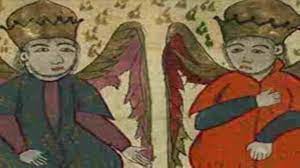
(Picture of Harut and Marut)
Harut and Marut are the, er, angels memorialized in the name of the city of Los Angeles.
In 922 B.C., “good” King Solomon married the Pharoah’s daughter and took up idolatry. He built temples to Moloch, Ashtoreth and Remphan. Remphan’s symbol is the six-pointed star that would be known from then on as “the seal of Solomon”.
“And Solomon became allied to Pharaoh king of Egypt by marriage, and took Pharaoh’s daughter, and brought her into the city of David, until he had made an end of building his own house, and the house of the Lord, and the wall of Jerusalem round about.”
1 Kings 3:1
The Hebrews changed the name Remphan to Chiun, which means “Saturn”.
(Gigantic image of Saturn painted inexplicably in the background in a 1930’s Hollywood musical, from “Hollywood Babylon II”, by Kenneth Anger, 19)
Has anyone here besides myself noticed that “Chiun” and “Renpu” are both Chinese words?
From 900 B.C. to 600 B.C., the Homo Neanderthalensis Chinese ruled Turkey, Assyria and Israel.
“Hittite versions of the Sargon and Naram-Sin accounts have been found in Anatolia. Increasing Assyrian and Babylonian influence and eventually domination of Syria and Israel during the ninth through sixth centuries would have influenced the written biblical version of the story.”
In 800 B.C., two mosaic glass blood beakers were used in a Chinese “Kassite” human sacrifice temple in what is now Iraq. This is the precursor of the modern jug for “communion wine”.
Wikipedia: “Glass works - Remnants of two Kassite glass beakers were found during the 1964 excavation in a (c. 800 BC) destruction layer of Hasanlu, in northwest Iran. The mosaic glass beakers are thought to have been heirlooms, possibly for ritual use the find spot being a temple. The panes of glass used to create these images were very brightly colored, and closer analysis has revealed that they were bright green, blue, white, and red-orange.[54]. A Kassite text found at Dur-Kurigalzu mentions glass given to artisans for palace decoration and similar glass was found there.[55] Other similar glass dated 1500 BC was found at Tell al-Rimah.[56]”
Now take a look at the fragments of those jugs, festooned with the sacred six-pointed stars that the Chinese had been preserving at the heart of their human sacrifice culture for over three thousand years:
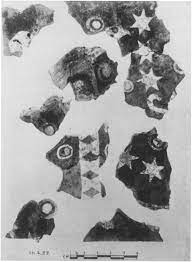
(Chinese “Kassite” mosaic glass blood beakers, emblazoned with the six-pointed “Star of Remphan” found in a human sacrifice temple in Hasanlu, in Northwest Iran, 800 B.C. The six-pointed star in China goes back at least to the Hongshan culture in 4,700 B.C.)
Here, in 700 B.C., a Chinese “Babylonian” relief in Mesopotamia depicts Baal walking with his axe and his arrows, in exactly the same way he was depicted by the Israelites who brought him to Egypt.
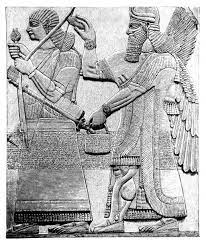
(The tellingly clipped-bearded or non-bearded Baal, left, with H. Neanderthalensis Chinese bow, arrows, axe)
In 300 B.C., the Chinese took over the entirety of Sumeria. The victorious Chinese “King of Kish” who was “victorious in war”. Kish was rebranded to Cush to confuse the trail.
The “Gutean” people who’d controlled the area for the Chinese turned it back over to them, and moved on their inexorable way toward being “European”, and supposedly unconnected with the Chinese in any way. Divide and conquer, East vs. West, same side controls all the sides.
In 1847, the Louvre in Paris presented its first ever exhibit of Assyrian antiquities.
In 1894 Babylonian excavations began in earnest.
In 1916, Freemason D.W. Griffith produced “Intolerance”. Here’s a still from it:
(Babylonian still from D.W. Griffith’s “Intolerance”)
It’s not like these people aren’t right up front about what they’re into, and what they’re doing.
Here’s part of the set from Intolerance, the “Babylon Gate” in Hollywood, California. Note Chinese Emperor Sargon II, on the right side of the gate:

(Babylon gate)
The angels of the city of Los Angeles are the Babylonian Black-magic-practicing Harut and Marut. Here’s a funny but very accurate paragraph from stolenhistory.net:
“Most people, if they have given any thought to the matter, imagine that the eponymous “angels” of this metropolis are the benevolent sort that help baseball teams win the pennant or go bicycling with Nicholas Cage. But in fact Los Angeles are the twin fallen angels Harut and Marut of Babylonian lore which are described in the Quaran as “masters of evil.”
Wikipedia: “Harut and Marut (Arabic: هَارُوْت وَمَارُوْت, romanized: Hārūt wa-Mārūt) are two angels mentioned in Quran 2:102, who are said to have been located in Babylon.[1][2] According to some narratives, those two angels were in the time of Idris. The Quran indicates that they were a trial for the people and through them the people were tested with sorcery. In the Quran, the two angels are briefly mentioned as follows:[4][5]
‘They followed what the Shayāṭīn (devils) gave out, in the Mulki Sulaymān (مُلْكِ سُلَيْمَان, Kingdom of Solomon). Sulaymān did not disbelieve, but the Shayāṭīn disbelieved, teaching men magic and such things that came down upon the two Angels in Babylon, Hārūt and Mārūt,’.”
Here’s a picture of Harut and Marut, hanging in punishment for being critical of Adam’s fall:
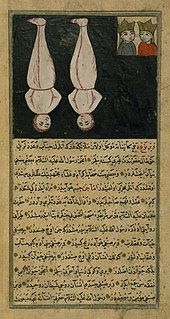
(Harut and Marut, hanging in punishment for being critical of Adam’s fall)
Now here’s a picture of Douglas Fairbanks as the drug-addicted “Inspector Coke Ennyday” from “The Mystery of the Leaping Fish”, 1916, with stylized Harut and Marut figures hanging prominently and inexplicably in the background:
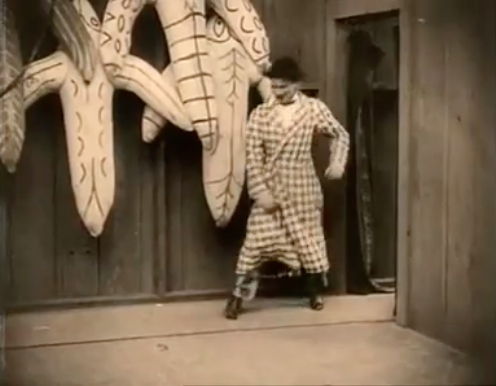
(Douglas Fairbanks as the drug-addicted “Inspector Coke Ennyday” from “The Mystery of the Leaping Fish”, 1916, with stylized Harut and Marut figures in the background.)
In 1927, Grauman’s Chinese Theater was built in Hollywood, California.
Wikipedia: “The original Chinese Theatre was commissioned following the success of the nearby Grauman’s Egyptian Theatre, which opened in 1922. Both are in Exotic Revival style architecture.[2] Built by a partnership headed by Sid Grauman over 18 months beginning in January 1926, the theater opened May 18, 1927, with the premiere of Cecil B. DeMille’s The King of Kings.[3] It has since been home to many premieres, including the 1977 launch of George Lucas’ Star Wars,[4] as well as birthday parties, corporate junkets, and three Academy Awards ceremonies. Among the theater’s features are the concrete blocks set in the forecourt, which bear the signatures, footprints, and handprints of popular motion picture personalities from the 1920s to the present day.”
Here’s a picture of it:
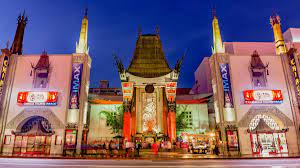
(Grauman’s Chinese Theater)
Here’s a quote from Kenneth Anger’s 1975 tell-all “Hollywood Babylon”, referring to the teens and twenties in Hollywood:
“As if all of this did not suffice, there was a “dope angle” to the case. Reporters stated that Taylor had recently been visiting the “queer meeting places” in L.A. and Hollywood, dens where strange effeminate men and particularly masculine women dressed in kimonos sat in circles, where guests were served marijuana, opium and morphine, the drugs wheeled in on tea carts.”
From “Hollywood Babylon, by Kenneth Anger, 1975
Can you see how Anger hilariously put “marijuana” in front of the Chinese opium being consumed in the Chinese opium den, and then tacked “morphine” on the end to further obscure the, er, Chinese connection?
He also brazenly uses the Japanese kimono, to further muddy the trail.
The culture, the apostasy is purely Chinese.
Hollywood is and has always been about the Black magic that came directly from China.
It’s why movie actors are called “Stars”.
And it’s why the name of the Jack Nicholson film is “Chinatown”.


